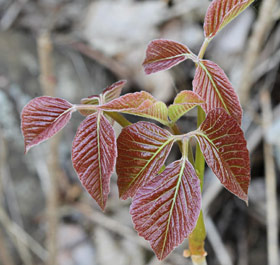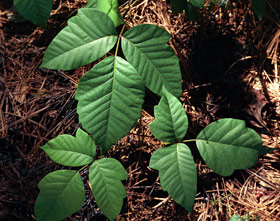Poison Ivy, Toxicodendron radicans

Poison ivy (Toxicodendron radicans) leaves emerging mid-May. Photo by Rob Routledge, Sault College, Bugwood.org.
IPM Steps to Reduce Poison Ivy
1. Sample for Pest
Where to find it while inspecting: Poison ivy tolerates some shade but prefers sun. Look for it in tall grass and weedy areas—rarely in regularly mowed turf. In school settings it is most often found along fence-lines, along walls, up trees and telephone poles. New growth is reddish.
2. Proper ID
Size and Particulars: Leaves up to 4–5 inches and always in groups of three. Leaves are generally shiny but can be dull when very mature. Mature plants that have vined can have thick, ropy woody “trunks”. Young plants have soft stems. Leaves can also vary as they are generally not toothed—but they can be toothed and even lobed. The key is the three leafed growth.
3. Learn the Pest Biology
Life Cycle: New leaf growth in spring is red and shiny and can originate from nodes on the vine or as new plantlets from the soil. In the fall leaves fade to a dull yellow or red. Flowers are tiny in long clusters of yellowish-white that become small, round, white fruit clusters. Plants propagate by vine and rootstock, not by fruit.
Preferred Habitat: Prefers sun to shade and moist soil to dry but can tolerate both. It is unlikely to grow in full shade. Young plants cannot tolerate frequent cutting. Large vines with woody stems are well-established and hard to eradicate.
4. Determine Threshold

Poison ivy (Toxicodendron radicans) foliage. Photo by James H. Miller & Ted Bodner, Southern Weed Science Society, Bugwood.org.
Threshold: Low threshold. You will want to stop active growth when you have a chance due to the high likelihood of allergic reaction.
5. Choose Tactics
Best Management Practices: Mow or cut back young growth often. Cut vines at the base and check back for new growth. Remember that the oil is the allergen and will remain on tools, clothes, boots, and gloves. See below for more details.
Treatment Methods: The best treatment is prevention—don’t allow new plants to become established. Cut back new growth at base of plant or trunk. NOTE: risk of exposure if using a string weeder! In some cases, spot application of a nonselective herbicide is helpful—follow pesticide use laws in your state and district guidelines. PLANT STEMS, AERIAL VINES and UNDERGROUND CREEPING STEMS are all capable of producing new nodes and leaves, so treatment must be continued with close monitoring.
6. Evaluate
Was the tactic successful? Record the date pests were first noted, and the tactic you used, and its success. Use one of our RECORD KEEPING tools.
For More Information
FDA Consumer Health Information: Outsmarting Poison Ivy
University of Connecticut Cooperative Extension: Poison Ivy
Penn State Extension: Poison Ivy Myths
Remember:
When a pesticide application is necessary, all necessary and required precautions are taken to minimize risk to people and the environment and to minimize risk of pesticide resistance or pest resurgence. Pesticide use in your school may be prohibited or regulated by local policies or state and federal regulations. Risk reduction methods can include, but are not limited to, spot-treatment, the use of gel or paste bait formulations placed in inaccessible locations, injection into a crack or crevice, and other methods that reduce potential exposure.